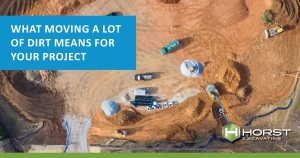What You Need To Know About Moving Dirt

When preparing for a construction project, it is easy to focus on the details of the things you will be able to physically see and touch when the project is complete – things like fresh architectural finishes, exciting new technological systems, and the selection of building materials.
One thing that might not even be on your radar is the dirt your project will be built on. It is surprisingly rare that a construction project has the correct ratio of dirt from the beginning. In most cases, there will be either too much dirt – requiring the site work contractor to export it, or not enough dirt – requiring the site work contractor to import it.
We know how overwhelming the process can feel when you are in the planning stages of a construction project and you hit a snag. With 60-years’ experience, Horst Excavating knows dirt. We are here to provide some guidance with the basics you need to know about moving dirt on construction projects.
Almost all construction projects require some form of site work or excavation, and there are a few different ways this process can vary depending on your site and your new building. Any aspect of the building that goes underground requires the displacement of dirt. That’s why large piles of dirt are a familiar sight on construction projects. But what happens to them as the project progresses?
But as a quick note, proper erosion control measures should be in place before any dirt is moved, and dirt piles in Pennsylvania will need to be seeded and mulched. If your team is working on an NPDES permit in Pennsylvania, you’ll need an approved plan for any spoils or borrow areas, as well as being a co-permittee to the NPDES permit.
Creating Piles of Dirt
When carving out the foundation of your building, large mounds of dirt can accumulate on the jobsite. The deeper the foundation or the larger your footprint, the bigger these piles will be. But your building’s basement isn’t the only component of a project that ends up below grade.
Other activities like digging retention basins and trenches for utility equipment will create excess dirt. Even the grading of land in road or parking lot construction can generate a great deal of excavated material.
Most jobsites have either one of two problems: too much excavated dirt or not enough. Depending on your project, you may need to move dirt off the site, or have dirt brought in. Either one can potentially impact the project’s bottom line.
What Happens With Excess Dirt?
If the excess dirt is clean and contaminate-free, it can be put to use in a variety of applications. Depending on the project’s site plans, the dirt can be used in other areas of the project. Just like the grading of land creates excess dirt, it also requires excess dirt to fill in holes and divots.
It can also be compacted and used as part of the foundation itself. Depending on how much you’d like to alter the land your project is being constructed on, your excavator can craft hills and inclines with the extra dirt as well.
Excess dirt may also be taken by local organizations like parks and school districts, who will use the fill dirt for their own landscaping and planting projects. Or the dirt can be used to fill reclaimed mine sites, helping to level off the large holes left by decades of mining. The piles can also be transported to other construction projects if there is a need. Your site work contractor may also work out other situational agreements where fill dirt is needed by a local farmer or organization. In some instances, since the fill dirt is being donated the organization receiving it will arrange for transportation of the material, making it an inexpensive option. In others, the trucking fees should be anticipated for transporting the dirt off-site.
If none of these options suffice, the excavator will take it to a landfill to dispose of it. Typically, a cost per pound or per cubic foot will be charged to dump the dirt. This last resort option is generally the most costly as it not only requires the dumping fees but also the cost to truck all of the dirt off-site.
Importing Dirt to Your Site
Some projects may not have enough excess dirt for all their needs and may require additional dirt to be moved to their project. This is where excavators move dirt from one project to another with large dump trucks. If you’re creating a building with a relatively small footprint but have a good deal of grading or land alteration, you may need to secure extra dirt from somewhere.
This can also come into play if your project requires a more sophisticated stormwater management system, like a rain garden. Rain gardens use a mixture of specific dirt types to filter out pollutants from rainwater before going to the water supply. Dirt may need to be transported to your site to create the correct mixture of soil for filtration.
Transporting dirt to your jobsite will add additional cost to your project. The cost for both the material and the delivery should be anticipated. In some cases, there is an opportunity for savings when your site work contractor or another member of your building team is able to secure fill dirt from a nearby project at little or no cost. This can be a win-win situation for both parties as it saves the dumping fees for those looking to off-load dirt and the import fees for those looking to bring dirt in for their project.
You Deserve a Partner That Brings Solutions
While a project can be dirt-neutral – meaning it uses all the displaced dirt – many projects require balancing. Some projects need extra dirt while some projects have dirt to get rid of. Regardless of your project’s challenge, Horst Excavating has the experience and equipment to efficiently create a solid foundation and beautiful grounds. We are a fully bonded and insured site work contractor that is proud to bring solutions that save our clients time, money, and headaches. Give us a call today to find out how we can help your project find balance!
Posted July 13, 2020

